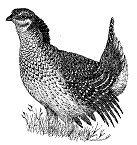Papers in the Biological Sciences
Document Type
Article
Date of this Version
1878
Abstract
BEING A LIST OF BIRDS OBSERVED IN THE VICINITY OF FORT BROWN, TEXAS, FROM FEBRUARY, 1876, TO JUNE, 1878.
The post of Fort Brown, Texas, in the immediate vicinity of which most of the following observations were made, is at the extreme southern point of the State, in latitude 25° 53' 16", longitude 97° 13'. It adjoins the town of Brownsville, on the left bank of the Rio Grande, and across the river is Matamoras, in the Mexican State of Tamaulipas. The nearest part of the Gulf coast is about eighteen miles distant. The surrounding country is level, and mostly covered with low chaparral; towards the coast this becomes more sparse, and gives place to extensive prairies, broken by shallow, brackish lagoons and sand ridges, with a scanty growth of cactus and Yucca. The average annual temperature is about 73° Fahrenheit; snow and ice are unknown, and slight frosts are rare. But little rain falls from March to September. This region offers an excellent field for the ornithologist. Besides a very large number of northern migrants that either remain throughout the winter or pass farther south, there are many forms characteristic of the river valley, and other Mexican species, either regular summer visitors or stragglers that are new to the United States fauna. A number of the latter class were obtained within our limits for the first time, and others by Mr. G. B. Sennett; but there are doubtless many more yet to be found.
Of the localities mentioned in this list, Brazos and Padre Islands are the parts of the Gulf coast nearest the fort; they are long, narrow sand ridges, almost destitute of vegetation. A similar formation is seen in the outer beach on the south shore of Long Island. Santa Maria and Edinburgh (now Hidalgo) are on the river, about twenty-eight and sixty miles respectively above the fort by road. Here the character of the country changes; the trees are much higher, and near the last-named settlement the land begins to rise. The avifauna, too, is somewhat different, and three species in particular stop abruptly there. As a matter of local interest, an asterisk is prefixed to those species that are known to breed within the limits of the fort and government reservation.



Comments
WASHINGTON: GOVERNMENT PRINTING OFFICE. 1878.